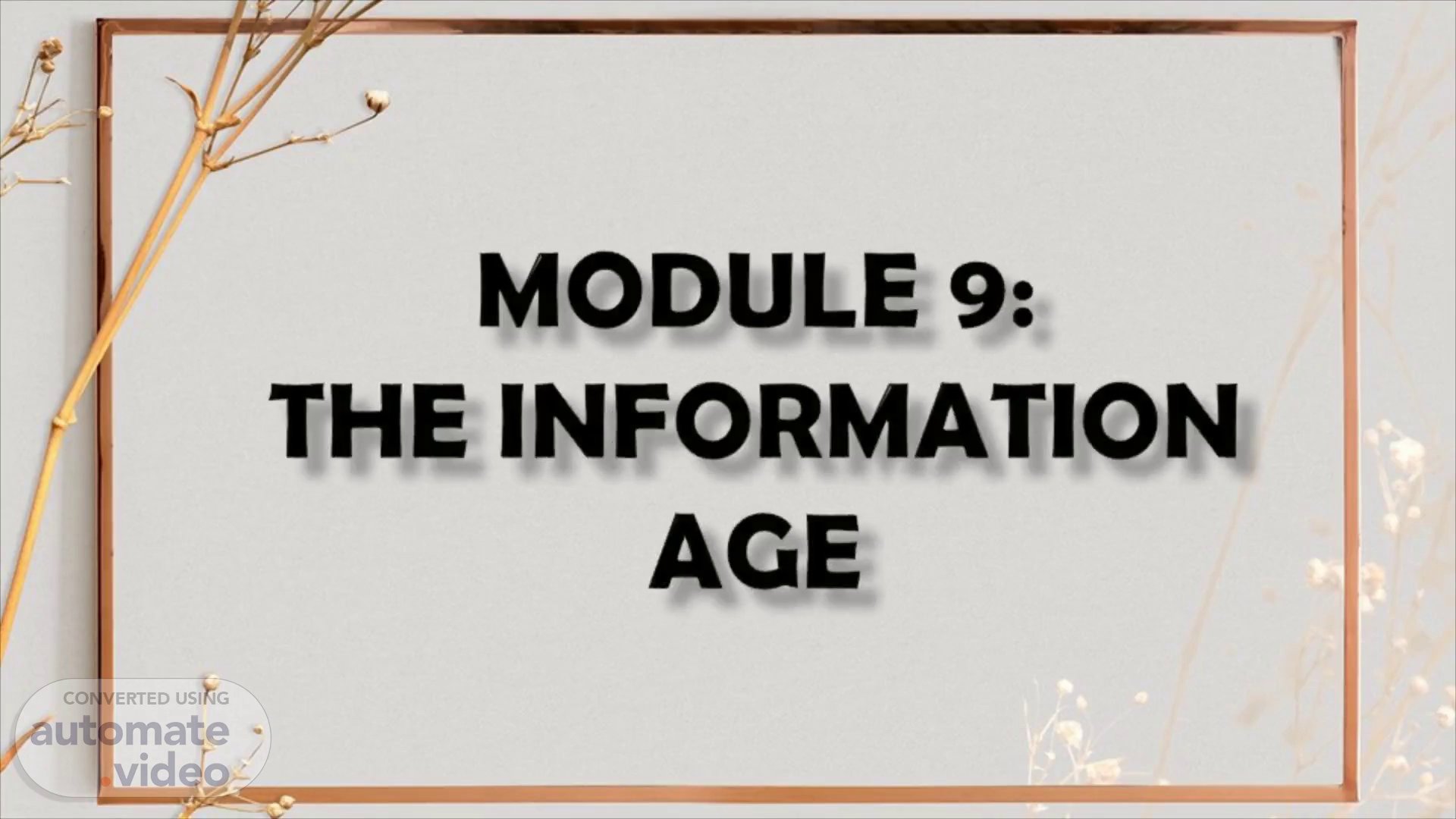
Module 9: The Information Age
Scene 1 (0s)
Module 9: The Information Age.
Scene 2 (10s)
What is Information Age?. Information Age is also called the Digital Age and the New Media Age . Information Age is a true new age based upon the interconnection of computers via telecommunications primarily driven for convenience, user-friendliness and user dependence. Information Age is defined as the modern age regarded as a time in which information has become a commodity that is quickly and widely disseminated and easily available especially through the use of technology ..
Scene 3 (1m 11s)
The Gutenberg Era and Some Facts about Information Age.
Scene 4 (1m 18s)
Johannes Gutenberg German craftsman and inventor Known for making the first movable printing press His greatest accomplishment was the first print run of the Bible in Latin He introduced printing to Europe with the printing press.
Scene 6 (1m 32s)
Truths of the Information Age (Robert Harris). 1. Information must compete. 2. Newer is equated with truer. 3. Selection is a viewpoint. 4. The media sells what the culture buys. 5. The early word gets the perm. 6. You are what you eat and so is your brain. 7. Anything in great demand will be counterfeited. 8. Ideas are seen as controversial. 9. Undead information walks ever on. 10.Media presence creates the story. 11.The medium selects the message. 12.The whole truth is a pursuit..
Scene 7 (1m 39s)
The Internet and the World Wide Web. LESSON 2.
Scene 8 (1m 46s)
What is internet?. Worldwide system of interconnected networks in facilitating the transmission of variety of data and information. In the early 1960s, the idea of an “Intergalactic Network” of computers was popularized by Joseph Carl Robnett Licklider. ARPANET is the first workable prototype of internet and was funded by the U.S Department of Defense to allow the connection of multiple computers. Internet was mainly used during 1970s for military transactions and some research activities..
Scene 9 (2m 25s)
Internet Server Desktop PC Modem Switch Desktop PC Router [Firewall Workstation Desktop PC WiFi iPhone Laptop Computer Smartphone.
Scene 10 (3m 1s)
Transmission Control Protocol / Internet Protocol.
Scene 11 (5m 26s)
World Wide Web. Invented by a British scientist, Tim Berners-Lee in 1989. The web is the most common means of accessing lots of interconnected documents and resources online with their specific locations in the form of websites and hyperlinks ..
Scene 12 (5m 56s)
Difference between World Wide Web and Internet. The World Wide Web are the pages you see when you’re at a device and you’re online. The internet is the network of connected computers that the web works on, as well as what emails and files travel across..
Scene 13 (6m 28s)
Issues and Challenges on “Surfing the Net”. Cyber Threats Phishing - attacks whereby spam emails are sent out, purporting to be from a bank, asking the recipient to confirm their bank security information by responding to a specified electronic address. Covert Filming - using digital cameras and the uploading of images taken on the Internet. Cyber Bullying Includes sending, posting, or sharing negative, harmful, false, or mean content about someone else. The use of electronic communication to bully a person, typically by sending messages of an intimidating or threatening nature..
Scene 14 (7m 56s)
Guidelines in Checking the Reliability of Web Sources.
Scene 15 (9m 9s)
4 . Who is the intended audience? Scholars or the general public? Which age group is it written for? Is it aimed at people from a particular geographic area? Is it aimed at members of a particular profession or with specific training? 5. What is the quality of information provided on the website? Timeliness: when was the website first published? Is it regularly updated? Does the author cite sources? What type of other sites does the website link to? What type of sites link to the website you’re evaluating? 6. How does it all add up? Does this website provide an appropriateness of fit?.
Scene 16 (9m 50s)
Informational Resources are those which present factual information. (.edu, .org) Advocacy Resources are those sponsored by an organization. (.org) Business or Marketing Resources are those sponsored by a commercial entity that is trying to sell products. (.com) News Resources are those which provide extremely current information on hot topics. (.com) Personal Web Pages/Resources are sites such as social media sites: blogs, Twitter pages, Facebook, etc..
Scene 17 (10m 38s)
Netiquette. LESSON 3.
Scene 18 (10m 45s)
Netiquette is a term used for Network Etiquette, or Internet Etiquette. The correct or acceptable way of communicating on the internet. It includes proper manners for sending e-mail, conversing online, and so on..
Scene 19 (10m 52s)
Important Guidelines (Virginia Shea). Remember the human – this is the Golden Rule of internet communications. Always be aware that you are talking to a person, not a device. Therefore, the same rules of courtesy apply. Adhere to the same standards of behavior online that you follow in real life. Know where you are in cyberspace – netiquette varies from domain to domain. What is acceptable in a chat room may not be appropriate in a professional forum so “think before you click”. Respect other people’s time and bandwidth- not everyone has stable internet connection and time zones. Make yourself look good online – spelling and grammar count! Always write thoughtful posts and keep your language clean. Share expert knowledge. Help keep flame wars under control. Respect other people’s privacy. Don’t abuse your power. Be forgiving of other people’s mistakes ..
Scene 22 (14m 5s)
Group 6. 07/0' II. Magro, Ma. Christina. Cañon, Ana Maria.